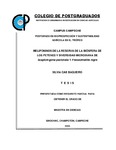| dc.description.abstract | Las abejas sin aguijón (ASA) o meliponinos son abejas nativas sociales que, se encuentran distribuidas principalmente en selvas tropicales y subtropicales y son considerados vitales para la conservación de estos ecosistemas. Estas abejas establecen asociaciones con una gran diversidad de microorganismos (microbiota) de gran importancia para su sistema inmunitario y digestivo. En México se reporta que la mayor diversidad de ASA se encuentra en el sureste. En el estado Campeche a pesar de ser el segundo estado con mayor extensión de Áreas Naturales Protegidas (ANP) en México, existen pocos reportes de muestreos de especies de ASA, y ninguno en cuanto su microbioma. Por tal razón, este trabajo tuvo como objetivo determinar la densidad de nidos de ASA presentes en la Reserva de la Biosfera de los Petenes y la diversidad microbiana asociada a Frieseomelitta nigra y Scaptotrigona pectoralis. Para ello, se realizaron muestreos mediante transectos lineales en dos sitios dentro de la reserva colindantes con dos municipios (Hecelchakan y Calkiní), para la búsqueda de nidos. La identificación de las ASA se realizó usando claves taxonómicas. De igual forma, se tomó el registro de las especies arbóreas que sirvieron como sustrato para la nidificación. Asimismo, se realizó la identificación de la comunidad microbiana de las especies de S. pectoralis y F. nigra, así como la evaluación de su funcionalidad bioquímica. Como resultado de nuestro estudio, se identificaron ocho especies de abejas sin aguijón entre ellas, Cephalotrigona zexmeniae, Frieseomelitta nigra, Lestrimellita niitkib, Nannotrigona perilampoides, Partamona bilineata, Plebeia frontalis, Scaptotrigona pectoralis y Trigona fulviventris. El mayor número de nidos localizados, perteneció a las especies F. nigra (n=23) con un 41% y S. pectoralis (n=16) con un 29%. La especie arbórea utilizada con mayor frecuencia para anidación correspondió a Crescetia cujete debido a su predominancia en el hábitat. Se encontró una densidad de nidos por hectárea, 2.15 en el sitio Hecelchakán y de 0.19 en el sitio de Calkiní. El análisis microbiológico de la microbiota interna y externa permitio identificar 42 cepas bacterias en S. pectoralis y F. nigra, pertenecientes a diez géneros tales como, Bacillus, Curtobacterium, Enterobacter, Klebsiella, Kocuria, Ochrobactrum, Pantoea, Pseudomonas, Sinorhodobacter y Staphylococcus. De igual manera, se identificaron 3 cepas de la levadura a Candida metapsilosis. Se encontraron cepas de Bacillus con importantes actividades aminolíticas, celulolíticas, lipolíticas, proteolíticas, solubilización de fosfato y ácidos orgánicos. La actividad lipolítica (47%) fue la actividad que estuvo presente en un mayor número de bacterias, seguido por la actividad solubilizadora de fosfato (44%) y la producción de ácidos orgánicos (29%). La especie Pantoea anthophila presentó importante actividad lipolítica, proteolítica y solubilización de fosfato. Estos resultados indican que los microorganismos podrían estar desempeñando un papel importante en la producción de enzimas que favorecen la digestión de sus alimentos o formación de materiales para el nido. _______________ STINGLESS BEES OF THE PETENES BIOSPHERE RESERVE AND MICROBIAL DIVERSITY OF Scaptotrigona pectoralis AND Frieseomelitta nigra. ABSTRACT: Stingless bees (SB) or meliponini are social native bees wich are mainly distributed in tropical and subtropical forests, they are vital for the conservation of these ecosystems. These bees are associated with a wide diversity of microorganisms of importance for their immune and digestive system. In Mexico, it is reported that the greatest diversity of SB is found in the southeast. In the Campeche state, despite being the second largest state of Protected Natural Areas (ANP), there are few reports of identification of SB species, and none as for their associated microorganisms. For this reason, this work aimed to determine the density of SB nests present in the Petenes Biosphere Reserve and the microbial diversity associated with Frieseomelitta nigra and Scaptotrigona pectoralis. For nest searches, linear transects were established at two sampling areas (Hecelchakan and Calkiní). The found species were identified using taxonomic keys. They were registred the tree species, where the nests were localized. The identification of associated microorganisms to the species S. pectoralis and F. nigra was carried out; as well as the evaluation of their biochemical functionality. In our study, eight species of SB were identified, Cephalotrigona zexmeniae, Frieseomelitta nigra, Lestrimellita niitkib, Nannotrigona perilampoides, Partamona bilineata, Plebeia frontalis, Scaptotrigona pectoralis and Trigona fulviventris were identified. Of which, the largest number of nests located, belonged to F. nigra (n = 23) with 41% of the total nests and S. pectoralis (n = 16) with 29%. In addition, there was the absence of M. beecheii, due to its susceptibility to the conditions of anthropic disturbance that characterized the sampling sites. The tree species most frequently utilized for the nesting of the species corresponded to Crescentia cujete, due to its predominance in the habitat. It was found a density of nests per hectare of 2.15 at the Hecelchakán site and 0.19 at the Calkiní site. The microbiota of 45 strains of associated microorganisms identified from the species S. pectoralis and F. nigra, were distributed in ten genus tales such as Bacillus, Curtobacterium, Enterobacter, Klebsiella, Kocuria, Ochrobactrum, Pantoea, Pseudomonas, Sinorhodobacter and Staphylococcus. Similarly, they were identified three strains of yeasts corresponding to a Candida metapsilosis. Bacillus strains were found with important aminolytic, cellulolytic, lipolytic, proteolytic, phosphorus solubilization and organic acids activities. The largest number of bacteria presented lipolytic activity, followed by phosphate solubilizing activity and organic acid production. The Pantoea anthophila species had an important lipolytic, proteolytic and phosphate solubilization activity. These results indicate that the microorganisms could be playing an important role in the production of enzymes that contributed to the digestion of their food or the formation of nest materials. | es_MX |


